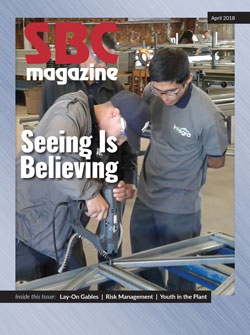Know Your Risk on the Road
Know Your Risk on the Road
Motor vehicle operation can be a significant source of risk and liability for component manufacturers (CMs). Whether you hire and train your own drivers or contract deliveries through a third party, you have responsibility over plenty of employees, cars and trucks while they’re on the road. In this article, SBCA legal counsel Kent Pagel provides guidance to CMs based on a few common scenarios.
Scenario 1:
I had an employee get rear-ended at a traffic light by an uninsured motorist while driving a company vehicle with company insurance. I never realized how little coverage for medical claims is built into an automobile policy! Our policy only offered five thousand bucks toward covering my employee’s torn rotator cuff. It seemed like we were being encouraged to turn toward health insurance or workers’ compensation coverage.
Coverage in a scenario like this can depend on many factors. Driver culpability plays a significant role in determining whose insurance is involved in a claim. Additional factors can also come into play. For instance, if the employee is on the clock at the time of the accident, health insurance or workers’ compensation coverage might come into play, but if the accident occurs outside of working hours, or if a contractor rather than a direct employee is involved, your auto insurance might be all you have to fall back on. If the other driver(s) involved doesn’t have insurance, or is under-insured, that will have an impact on how any claims are handled.
For companies whose business or employees cross state lines, it’s important to keep in mind that motor vehicle insurance requirements are set at the state level. While many states require coverage, not every state has robust enforcement of its requirements. In some states, individuals may purchase motor vehicle insurance, pay the first month’s premium and receive an insurance card that they can produce as needed, but then never pay additional premiums to continue the coverage. You should know – before an employee reports an accident – whether the areas you operate in are places where it may be common for drivers to abuse this loophole.
Scenario 2:
We outsource some of our deliveries. One day we had a driver call in sick and one of our third-party driver’s trucks broke down in our yard. The plant manager let that driver take our truck. Unfortunately, he only got a few miles down the road before someone pulled out in front of him and caused an accident. As a consequence, it goes on our insurance because it’s our truck, even though he wasn’t our driver.
If anyone other than your own employees are driving your trucks or hauling your trailers, you should seek legal advice on your risk exposure based on your insurance policy coverages and contractual obligations. Liability can follow the driver, the truck or just the trailer, depending on your coverages and/or stipulations in the contract governing its use.
For example, if it can be shown that a driver is operating outside the scope of their employment at the time of the crash, like in the scenario above, the driver’s personal insurance might be the primary coverage. This underscores the importance of understanding your coverages and your contracts, as well as thoroughly documenting your employees’ time on the job (i.e., detailed timesheet) and the duties being performed.
Scenario 3:
A private easement ran between our yard and the adjoining property. Dump trucks would use the easement and cross a set of railroad tracks. One day, a truck driver runs the warning lights and collides with a train. The plaintiff contended the lumber stacks we had unloaded the day before were blocking the driver’s line of sight. The city reviewed our stack heights and determined we were in compliance with the law. However, we lost the case in a jury trial.
Court testimony in a jury case can be a difficult situation even when fault seems clear cut. Juries are sometimes inclined to side with individuals instead of a company, and assertions that make sense in casual conversation – such as admitting there’s a better process to follow or indicating you intend to do things differently in the future – don’t necessarily make for a legally persuasive defense in a courtroom.
Self-inspections throughout your facilities, refresher training for your employees, and good legal counsel for the things you’re not likely to anticipate can all help ensure your contracts and insurance coverages are right for the road-related scenarios you might face.

